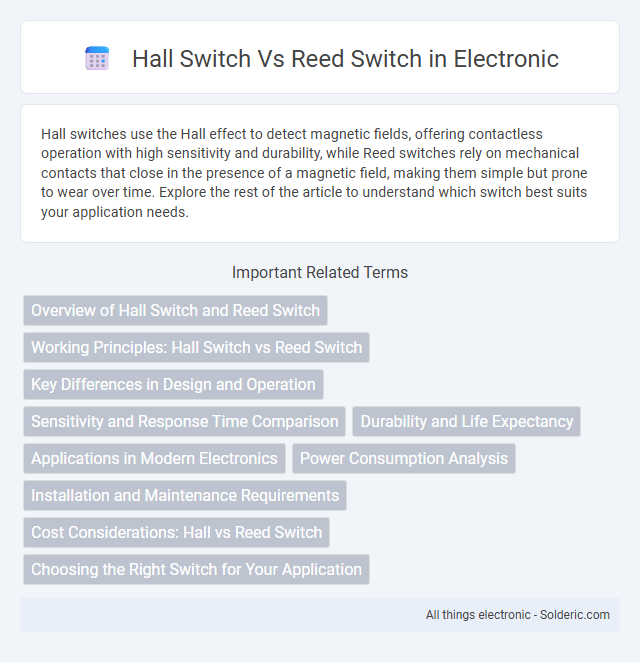Hall switches use the Hall effect to detect magnetic fields, offering contactless operation with high sensitivity and durability, while Reed switches rely on mechanical contacts that close in the presence of a magnetic field, making them simple but prone to wear over time. Explore the rest of the article to understand which switch best suits your application needs.
Comparison Table
| Feature | Hall Switch | Reed Switch |
|---|---|---|
| Operating Principle | Measures magnetic field using Hall effect sensor | Mechanical contacts close when exposed to magnetic field |
| Response Time | Fast (microseconds) | Slower (milliseconds) |
| Durability | High (solid-state, no moving parts) | Lower (mechanical wear from contact movement) |
| Power Consumption | Requires power supply | No power required (passive device) |
| Output Type | Analog or digital electrical signal | Mechanical switch (open/closed) |
| Operating Voltage | Typically 3.3V to 24V | Not voltage dependent |
| Contact Rating | Not applicable | Typically up to 10W |
| Temperature Range | -40degC to 125degC | -40degC to 85degC |
| Applications | Position sensing, speed detection, current sensing | Security systems, proximity sensing, switching |
| Cost | Higher | Lower |
Overview of Hall Switch and Reed Switch
Hall switches utilize the Hall effect to detect magnetic fields and provide digital or analog output signals, enabling contactless sensing with high durability and fast response times. Reed switches consist of two ferromagnetic blades sealed in a glass envelope that close or open an electrical circuit when exposed to a magnetic field, providing simple, reliable, and low-power operation. Both devices are widely used in position sensing, proximity detection, and speed measurement, with Hall switches offering solid-state technology and Reed switches relying on mechanical movement.
Working Principles: Hall Switch vs Reed Switch
A Hall switch operates based on the Hall effect, generating a voltage when exposed to a magnetic field perpendicular to the current flow, making it ideal for contactless sensing. Reed switches function through the mechanical movement of ferromagnetic reeds that close the circuit when a magnetic field draws them together, enabling a simple, physical on/off operation. Unlike reed switches, Hall switches offer faster response times, longer durability, and greater resistance to mechanical wear due to their solid-state design.
Key Differences in Design and Operation
Hall switches use semiconductor-based sensors to detect magnetic fields through the Hall effect, providing non-contact, solid-state switching with high durability and fast response. Reed switches rely on two ferromagnetic blades sealed within a glass tube that physically close or open the circuit when exposed to a magnetic field, offering simplicity but limited mechanical lifespan. Your choice depends on the need for durability, switching speed, and sensitivity, with Hall switches excelling in precision and Reed switches favored for cost-effective, low-frequency applications.
Sensitivity and Response Time Comparison
Hall switches exhibit higher sensitivity due to their ability to detect magnetic fields without physical contact, enabling precise measurements in low magnetic flux densities. Their response time is typically faster, often in the microsecond range, which suits high-speed applications. Reed switches, relying on mechanical movement, have lower sensitivity and slower response times, generally in milliseconds, making them less suitable for rapid switching needs but advantageous in simple on/off magnetic detection.
Durability and Life Expectancy
Hall switches exhibit superior durability and longer life expectancy due to their solid-state design, which eliminates mechanical wear and tear common in reed switches. Reed switches rely on physical contact of metal reeds that can degrade over time from repeated actuation and environmental factors, limiting their lifespan. Industrial applications favor Hall switches for consistent performance in harsh conditions, with typical operational cycles exceeding millions, compared to the relatively lower endurance of reed switches.
Applications in Modern Electronics
Hall switches excel in detecting magnetic fields without physical contact, making them ideal for precise control in automotive sensor systems, brushless DC motors, and position sensing in smartphones. Reed switches operate through mechanical contact, offering simplicity and reliability in security alarm systems, proximity sensors, and utility metering where low power consumption and durability are critical. Your choice between Hall and Reed switches depends on the required sensitivity, operating environment, and integration needs in modern electronic devices.
Power Consumption Analysis
Hall switches consume significantly less power compared to reed switches due to their semiconductor-based operation, typically requiring only a few milliamps at 5V supply voltage. Reed switches, relying on mechanical movement and magnetic contact closure, often experience higher power losses and limited efficiency in continuous operation. Hall sensors provide enhanced energy efficiency, making them ideal for battery-operated and low-power electronic devices.
Installation and Maintenance Requirements
Hall switches offer simpler installation with non-contact sensing, reducing wear and alignment issues, while reed switches require precise positioning and more frequent maintenance due to mechanical contacts. Your choice impacts long-term reliability, as Hall switches typically need less maintenance and perform better in dusty or harsh environments. Reed switches may require periodic replacement or cleaning to maintain optimal functionality.
Cost Considerations: Hall vs Reed Switch
Hall switches generally have higher upfront costs compared to reed switches due to their semiconductor-based design and more complex manufacturing process. Reed switches are typically more affordable, benefiting from a simpler mechanical structure and widespread availability. However, Hall switches offer longer lifespan and greater reliability, which can reduce maintenance and replacement costs over time.
Choosing the Right Switch for Your Application
Selecting the right switch depends on application requirements such as durability, sensitivity, and switching speed. Hall switches offer non-contact operation, longer lifespan, and better resistance to vibration, making them ideal for high-speed or harsh environment sensing. Reed switches provide a cost-effective solution with simple on/off switching using a magnetic field, suited for low-frequency or less demanding applications.
Hall switch vs Reed switch Infographic

 solderic.com
solderic.com